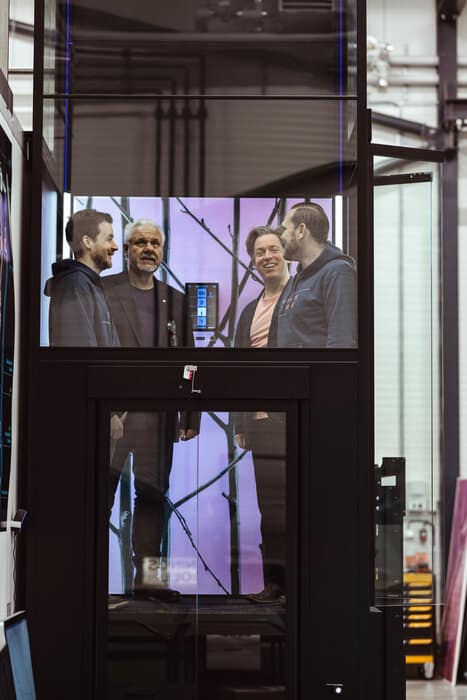
Overweegt u een lift in uw woning te plaatsen?naIs het gebouwd? Je bent niet de enige. In België maken steeds meer huiseigenaren en eigenaren van kleine gebouwen die stap – voor comfort, toekomstbestendigheid of gewoon voor een makkelijker leven.
Of het nu voor ouder wordende ouders is, gemak of gewoon toegevoegde waarde,het installeren van een lift na de bouw komt steeds vaker voor. Maar is het eenvoudig? Niet bepaald.
Het vereist een doordachte planning, deskundige hulp en een duidelijk beeld van wat er mogelijk is in uw ruimte. Deze gids leidt u door de belangrijkste dingen die u moet weten voordat u muren gaat slopen of een lift kiest.
Laten we beginnen.
Waarom zou u overwegen om na de bouw een lift te installeren?
De meeste mensen denken pas aan een huislift als zenaZe zijn bij ons ingetrokken. Maar het leven verandert, en onze behoeften ook.
- Mobiliteitsproblemen komen vaak op de eerste plaats. Naarmate gezinsleden ouder worden, kunnen trappen een echte uitdaging worden. Een lift lost dat direct op.
- Planning: Ook al is iedereen nu gezond, toch is het verstandig om uw huis toekomstbestendig te maken.
- Gemak nodig: Boodschappen of meubels tussen verdiepingen sjouwen wordt snel saai. Een lift maakt het leven makkelijker.
- Het voegt waarde toe: Een strakke, goed geplaatste lift kan de aantrekkelijkheid van uw woning op de markt vergroten.
Ook in België zijn kleine gebouweigenaren steeds meer op de hoogte en voegen huisliften naar verhuur of boetiekhotels om op te vallen en toegankelijk te blijven.
Is het mogelijk om een lift te installeren na de bouw?
Ja, het installeren van een lift na de bouw is mogelijk. Het is echter niet zo eenvoudig als het in een lege schacht steken. Het succes hangt af van verschillende factoren:
- Indeling van het gebouw: De bestaande structuur bepaalt waar een lift kan worden geplaatst zonder ingrijpende renovaties.
- Beschikbare ruimte: Liften hebben een minimale hoeveelheid ruimte nodig, niet alleen voor de cabine, maar ook voor de mechanische componenten.
- Structureel draagvermogen: Het gebouw moet het extra gewicht en de dynamische krachten van de lift kunnen dragen.
- Lokale regelgeving: De Belgische bouwvoorschriften en veiligheidsnormen moeten worden nageleefd.
Het aanpassen van een lift vereist een andere aanpak dan het plannen van een lift tijdens nieuwbouw. Bij nieuwbouw kan vanaf het begin worden voorzien in specifieke ruimte, schachten en stroomvoorziening, terwijl bij renovaties rekening moet worden gehouden met wat er al is.
Soorten liften die het meest geschikt zijn voor renovaties
Wanneer het installeren van een lift na de bouwHet kiezen van het juiste type maakt het verschil. Gelukkig zijn er innovatieve opties die speciaal voor renovatieprojecten zijn ontwikkeld.
- Compacte huisliften zijn ideaal voor kleine ruimtes. Ze zijn zelfvoorzienend en hebben geen grote schachten nodig, waardoor ze in bestaande woningen passen.
- Asloze liften Sla de traditionele schacht volledig over. Als de ruimte beperkt is, is dit een van de meest flexibele keuzes.
- Liften door de vloer Beweeg tussen twee niveaus door door een gat in de vloer te gaan: eenvoudig, overzichtelijk en ruimtebesparend.
- Platformliften zijn ideaal voor kleine verhogingen of verbeteringen aan de toegankelijkheid. Denk aan een paar trappen of twee verdiepingen in een kleinere woning.
De beste keuze hangt af van je indeling, het aantal verdiepingen en wat je bereid bent te besteden. Een kort gesprek met een expert kan je helpen de juiste keuze te maken.
Belangrijke overwegingen voordat u met uw liftproject begint
Bij het starten van een liftrenovatieproject moet u goed rekening houden met een aantal belangrijke factoren. Zo weet u zeker dat de installatie veilig, kosteneffectief en aan uw behoeften voldoet.
1. Ruimtevereisten
Een van de grootste uitdagingen is het vinden van een geschikte ruimte voor de lift zonder kostbare structurele aanpassingen te doen. Veelvoorkomende aandachtspunten zijn:
- Trappenhuizen of trappenhuizen aangrenzende ruimtes
- Kasten of ongebruikte kamers
- Gebieden in de buurt van bestaande schachten (indien aanwezig)
De specialisten van Swift Lifts kunnen uw terrein inspecteren om de beste locatie te vinden om overlast en bouwwerkzaamheden tot een minimum te beperken.
2. Elektrische en technische haalbaarheid
Liften hebben een betrouwbare en voldoende stroomvoorziening nodig. Vóór de installatie:
- Controleer of uw bestaande elektrische systeem de energiebehoefte van de lift aankan.
- Beoordeel of er upgrades of extra circuits nodig zijn.
Zo voorkomt u verrassingen tijdens de installatie en bent u verzekerd van veiligheid en naleving van de Belgische elektrische normen.
3. Toegankelijkheidsdoelen
Maak duidelijk wie de lift het meest zal gebruiken:
- Oudere familieleden of mensen met een beperking hebben mogelijk grotere cabines of soepele, eenvoudig te gebruiken bedieningselementen nodig.
- Bij normaal gezinsgebruik kunnen snelheid en stijl de boventoon voeren.
- Voor de toekomstbestendigheid is mogelijk een veelzijdig ontwerp nodig dat later kan worden aangepast.
Inzicht hierin is essentieel bij de keuze en het ontwerp van de lift.
4. Lokale bouwvoorschriften en vergunningen
België kent strenge regels voor bouwaanpassingen, vooral voor huisliften:
- Voor de meeste installaties na de bouw is een vergunning vereist.
- Er moet worden voldaan aan de normen voor brandveiligheid, structurele integriteit en toegankelijkheid.
- SwiftLifts kan vergunningsaanvragen verzorgen en ervoor zorgen dat uw installatie aan alle wetgeving voldoet.
5. Budgettering en onderhoud op lange termijn
Hoewel de initiële install atiekosten belangrijk zijn, moet u ook rekening houden met het volgende:
- Doorlopende onderhoudskosten
- Mogelijke reparaties of vervanging van onderdelen
- Energieverbruik
Door financieel te plannen voor de levenscyclus van de lift, voorkomt u onverwachte uitgaven in een later stadium.
Het stapsgewijze liftinstallatieproces
Inzicht in het installatieproces helpt u zorgen weg te nemen en voorbereid te zijn op de volgende stap. Bij Swift Lifts begeleiden we u met expertise door elke fase. Zo pakken we het aan installatie van liften na de bouw in België:
Stap 1: Eerste consultatie en locatieonderzoek
Ons team bezoekt uw pand voor een gedetailleerde inspectie. We beoordelen de indeling van het gebouw en de beschikbare ruimte. Ook de bouwkundige staat en de elektrische infrastructuur worden gecontroleerd. Dit helpt bij het opstellen van een realistisch plan. Het is tevens een kans voor u om uw wensen kenbaar te maken.
Stap 2: Ontwerpplanning
Met de onderzoeksgegevens ontwerpen onze experts een liftoplossing op maat. We houden rekening met uw toegankelijkheidsbehoeften en technische beperkingen. We houden rekening met de stijl van uw huis voor een aantrekkelijke uitstraling. Er zijn diverse opties beschikbaar voor cabinegrootte, deuren en afwerkingen.
Stap 3: Vergunningverwerving en naleving
Wij regelen alle vergunningen en papierwerk. We werken nauw samen met de lokale autoriteiten om snel goedkeuringen te krijgen. Uw lift voldoet aan de Belgische veiligheids- en bouwvoorschriften. Dit voorkomt juridische vertragingen en zorgen.
Stap 4: Structurele voorbereiding
Nadat we uw vergunningen hebben ontvangen, bereiden we uw woning voor. Kleine verstevigingen kunnen worden aangebracht ter ondersteuning van de lift. Schachten of openingen kunnen worden gemaakt of aangepast. We minimaliseren de overlast en beschermen de constructie van uw woning.
Stap 5: Liftinstallatie en testen
Onze technici installeren de liftcabine, de bedieningselementen en de veiligheidssystemen. Precisie is essentieel voor een soepele werking. We voeren veiligheidstests, noodcontroles en wettelijke inspecties uit. De lift wordt pas in gebruik genomen nadat alle tests zijn geslaagd.
Stap 6: Overdracht en aftersalesondersteuning
Wij laten u zien hoe u de lift veilig gebruikt. SwiftLifts biedt onderhouds- en reparatieservices. Regelmatige controles houden uw lift jarenlang betrouwbaar. Wij staan altijd voor u klaar om u alle benodigde ondersteuning te bieden.
Tijdlijn en complexiteit
Projecten variëren in lengte. Eenvoudige installaties duren 2-3 weken. Complexe installaties kunnen langer duren vanwege vergunningen of bouwkundige werkzaamheden. We geven vooraf duidelijke tijdschema’s om u op de hoogte te houden.
Hoe kiest u de juiste lift voor uw bestaande pand?
Het kiezen van de juiste lift voor een bestaande woning kan lastig zijn, maar SwiftLifts maakt het eenvoudig. We bieden modellen die speciaal zijn ontworpen voor het installeren van een lift na de bouw, perfect voor retrofits.
- Platformliften zijn ideaal voor kleine huizen of villa’s met beperkte ruimte. Ze vereisen minimale structurele aanpassingen en passen op plekken met beperkte ruimte.
- Kleine woonliften Ze passen goed in duplexwoningen of woningen met meerdere verdiepingen. Ze bieden comfortabele cabines en passen mooi bij uw interieur.
- Doorlopende vloermodellen zijn ideaal als de verticale ruimte beperkt is. Ze bewegen door de vloer, waardoor er geen hele schacht nodig is.
U kunt de afmetingen, afwerkingen en deurstijlen aanpassen aan uw woning. Bij SwiftLifts richten we ons op de balans tussen functionaliteit, design en betaalbaarheid om de perfecte pasvorm te garanderen.
Veelvoorkomende uitdagingen en hoe SwiftLifts u helpt deze te overwinnen
-
Beperkte ruimte of hoofdruimte
Wij zijn gespecialiseerd in compacte, schachtloze en door de vloer lopende ontwerpen om de ruimte optimaal te benutten.
-
Geluid en visuele impact
Moderne liften zijn ontworpen voor een stille werking. Bovendien kan de afwerking worden afgestemd op het interieur van uw huis, voor minimale visuele verstoring.
-
Installatieverstoring
Ons team zorgt ervoor dat er zo min mogelijk lawaai en rommel ontstaat, zodat u zich geen zorgen hoeft te maken over uw dagelijkse leven.
-
Transparantie van budget en tijdlijn
Wij bieden u vooraf nauwkeurige schattingen en realistische tijdlijnen, zonder verborgen kosten of verrassingen.
Conclusie
Dus, kun je een lift installeren nadat je huis is gebouwd? Absoluut. Met een doordachte planning, de juiste lift en deskundige begeleiding is het niet alleen mogelijk, maar ook praktisch.
Bij SwiftLifts België, maken we het proces stressvrij en eenvoudig. Van het eerste locatiebezoek tot de uiteindelijke installatie begeleiden we u bij elke stap.
Wilt u uw mogelijkheden verkennen? Neem contact op voor een vrijblijvend adviesgesprek. Laten we eens kijken wat er mogelijk is in uw woning en hoe een huislift uw leven gemakkelijker kan maken, nu en in de toekomst.
Veelgestelde Vragen
Eerlijk gezegd is er niet veel ruimte. Sommige liften hebben slechts 1 of 2 vierkante meter nodig. Het hangt af van het type dat je kiest en waar je hem wilt installeren.
Voor kleine ruimtes zijn liften zonder schachten of liften die door de vloer gaan meestal de beste keuze. Ze nemen niet veel ruimte in beslag en vereisen geen ingrijpende verbouwingen.
Het duurt meestal een paar weken – ergens tussen de 2 en 6 weken. Het hangt af van hoe lastig de klus is en hoe snel je de vergunningen krijgt.
Ja, meestal wel. Maar maak je geen zorgen.SwiftLifts helpt met het proces, inclusief vergunningen en ervoor zorgen dat alles aan de code voldoet.
Wanneer een lift door professionals wordt geïnstalleerd, zal deze uw constructie niet verzwakken. Wij zorgen ervoor dat alle veranderingen zorgvuldig worden gepland en 100% veilig zijn.
Neem Contact Op!










